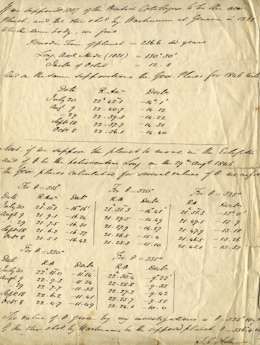|
ADAMS’
JULY
EPHEMERIS
Professor Challis emphasized his
use of a certain one-page document, in his report to the RAS. This
appears as being the first clearly dateable (within a month) document
that Adams gave to another concerning the position of the new planet.
It defines the planet’s likely positions in RA and Declination,
for the purpose of directing Challis’ sky-search. This document
has never been described or reproduced in the history books
-only Challis’ selective and partial account of it is reiterated,
as if the document itself did not need to be viewed.
Its page divides into two sections
from two different calculations. Both are based on circular, Bode’s
law orbits of the kind that Adams is supposed to have left behind
in early 1845, and neither draw upon his perturbation-calculations.
Its top section is based upon two anomalous star-position records,
where the objects found were later lost. Perhaps, Adams reasoned,
these were the new planet, its motion explaining why they could
not later be found. He gives a node position and therefore an inclination
to the circular orbit which he infers. Its position for August 29th,
1846 he concluded was ‘336° .4 nearly.' He chose that date
as being its heliocentric opposition (the Sun was then at 156° :
at helio opposition each year a planet appears brightest in the
sky).
Of the two ‘missing stars’
used by Adams, one was that seen by Flamsteed in 1690 (recorded
in the British Star-Catalogue as no. 1007),
and the other was that published in Comptes Rendus by the
Belgian Joseph Wartmann in 1836. From these Adams computed an orbital
motion some ten degrees away from that of Neptune.
The Chimera
of ‘Wartman’s Star’
Louis Wartmann made certain observations
at Geneva in 1831 which were published in 1836 (Comptes
Rendues Paris, 1836, 2, 307-11).
He claimed to have seen a new planet, at the Bodean distance of
38.8 AU from the Sun; and, noting it had not moved for a while,
he claimed this showed its retrograde station! He then lost his
star – or whatever it was - in 1832. Few took him seriously.
Wartman positioned it at co-ordinates equivalent to 314°
for September 6th, 1831 (14° Aquarius),
while Uranus was then at 313° . Fumbling
with his telescope, he had just seen Uranus. This was the reasonable
view of Sheehan and Baum:
'in fact, Wartman had simply "discovered" Uranus.’
(In Search of Planet Vulcan
p.120).
There was a mere one-degree difference between these positions.
Thus Adams was, in July of 1846, mistaking Uranus for Neptune. Contrary
to obfuscating comments that Challis made in his presentation to
the RAS, Adams appears as the sole British astronomer on record
as taking seriously Wartmann's claim to have observed the new planet.
Wartmann's 'observations' were
made a decade after the Uranus-Neptune conjunction, when the two
spheres were nine degrees apart. As the Harvard mathematician Benjamin
Pearce reported to the American Academy of Arts and Sciences in
Boston on 12th November, Wartmann's planet could not
have been more than eight or ten degrees from Leverrier's computed
orbit for Neptune (Hubbell
& Smith, JHA 1992 23, p266).
The second and lower half of Adams’
July ephemeris gives five possible positions for the planet over
a twenty-degree interval, the middle one being that specified in
Leverrier’s June 1st paper. For each of these positions,
its RA and Declination values are specified over two-wekly intervals
from July 20th to October 8th. This section
appears as a mere transcript from Leverrier's June 1st paper in
five respects:
- use of a circular orbit and
- its adoption of the Bode's-law
radius of 38 AU;

- the orbit used had no inclination
i.e. was in the ecliptic plane;
- the longitude on the 29th August
1846 was given as 325° , the same degree
as Leverrier's,
- and lastly, its five columns
span plus or minus ten degrees, the same confidence limit as in
Leverrier's paper.
That 325°
position which it advocated (cited by Challis at the RAS presentation)
was three degrees away in helio longitude from the position he was
later to claim had been given to Airy in the previous October and
is not a solution present in his manuscripts.
Adams was invited to produce a document
to guide the Cambridge sky-search, beginning in July. What he came
up with began and ended with references to ‘Wartmann’s
star’, its final conclusion being:
‘If the star obsd. by Wartmann
be the supposed planet, q
=
336° .4 nearly’
followed by his signature. Seeking
for a planet that was perturbing Uranus, he had used some delusive
readings as had derived from that same planet a decade earlier.
Thereby he recommended a value in error by ten degrees. |
